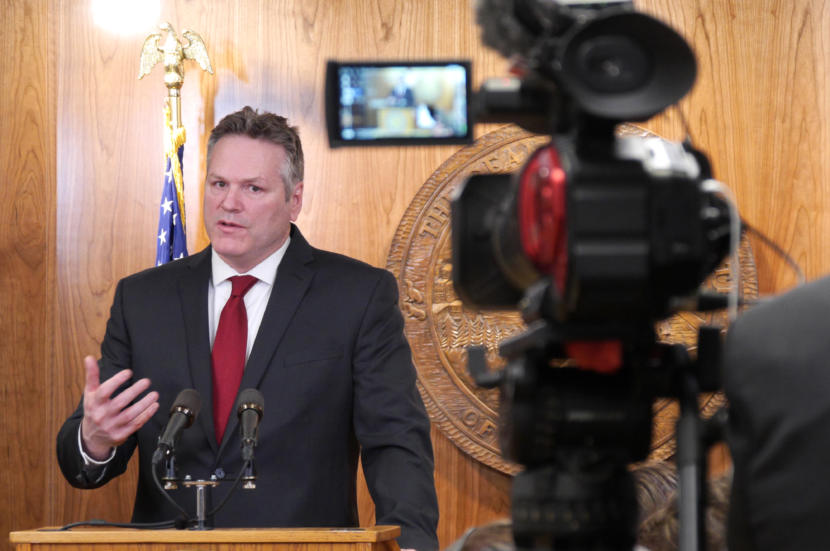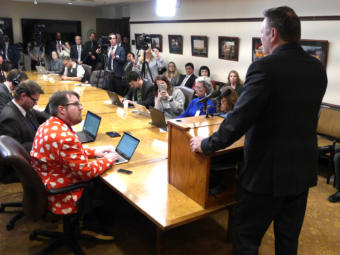
Alaska Gov. Mike Dunleavy proposed budget cuts Wednesday that could completely remake the state’s government and its education, health care and transportation systems.
But his power to reduce Alaska’s budget only goes so far — there are legal and political obstacles that stand between the governor and his goal of a balanced budget.
Alaska state government is a complex thicket of programs and services, each with its own set of constituencies. The Legislature also has its own budgeting powers. And some of the programs offered by the state require changes to laws or regulations before they can be cut back.

Take Medicaid, for example. Dunleavy proposed to cut more than $700 million, or about 30 percent, from the state-federal health care program, whose 210,000 beneficiaries include low-income Alaskans, pregnant women and people with disabilities.
But Dunleavy’s administration didn’t say specifically how it would would achieve the reductions — whether the state will pay lower rates to health care providers, for example, or cut off access to care for certain groups of Alaskans.
“Like health care in general, Medicaid is complex, and the governor’s ability to enact these changes will really depend on what the cuts are,” said Becky Hultberg, president of the Alaska State Hospital and Nursing Home Association, a trade group. “And we don’t know what the cuts are.”
Depending on what, exactly, Dunleavy proposes, his plans could require federal approval. Or the state Legislature might have to change Medicaid laws. And there’s no guarantee that the Trump administration, or the Legislature, will sign off.
Meanwhile, Dunleavy also proposed to close a huge chunk of Alaska’s $1.6 billion budget gap by boosting state tax revenue. The state would take the revenue — more than $400 million — away from cities and boroughs that collect it through property taxes that they levy on oil and gas infrastructure.
But before Dunleavy can take that step, lawmakers would have to pass a bill to eliminate the cities’ and boroughs’ taxing power. Each of those municipalities has at least one state representative and senator representing them. The North Slope Borough, which pays for most of its budget with oil and gas property tax revenue and would be most affected by Dunleavy’s proposal, has four lobbyists protecting its interests in Juneau.
“We will work with the governor and the Legislature to make our case. We want to be partners, not adversaries,” Mayor Harry Brower said in a prepared statement. “Because last time I checked, we are all Alaskans, and no one region should bear the brunt of the state’s fiscal problem.”
A lot of buzz today abt the Dunleavy proposal to remove municipalities’ ability to levy property taxes on oil & gas infrastructure and have that $ go to the state instead. Here’s a breakdown of what those sums looked like for Alaska municipalities in FY 2018. h/t @Nat_Herz #akleg pic.twitter.com/BcjQZAxbVf
— Ravenna Koenig (@vennkoenig) February 14, 2019
Programs that aren’t backstopped by specific laws or federal requirements could be more easily reduced. One of those is public broadcasting — Dunleavy proposed to completely eliminate the $2.5 million that the state sets aside for radio and TV.
KYUK, a regional station in the Southwest Alaska hub town of Bethel, gets about $150,000, or 10 percent, of its budget from the state. Shane Iverson, the station’s manager, said the reduction would equate to two of its 11 positions.
Advocates for programs like that were already strategizing about how they can change Dunleavy’s mind and rally state lawmakers to their defense.
“Those are the hopes, that the administration comes to learn how important public media is to Alaska, and at the same time that our Legislature hears from their constituents about how important public media is to their lives and livelihoods,” Iverson said.
But even if lawmakers reject some of the cuts that Dunleavy has proposed, veteran observers of the budget process were already looking forward to the governor’s trump card: his power to line-item veto money from individual programs.
That power is balanced by lawmakers’ ability to override Dunleavy’s veto. But doing so requires a three-fourths supermajority vote. And that’s a hard bar to clear, said Gregg Erickson, an economist and former publisher of the Alaska Budget Report.
“The constitutional structure in Alaska gives the governor unprecedented power,” he said. “It’s going to be, I think, difficult to ensure for certain that you have the three-fourths votes necessary to push the money, the appropriations out over the governor’s veto objections.”
Erickson said he expects Dunleavy to use his veto power to fulfill his budget-cutting objectives. And he suggested that anyone who opposes them should look to their legislators for support.
Ravenna Koenig contributed reporting from Fairbanks.
Watch the latest legislative coverage from Gavel Alaska:
